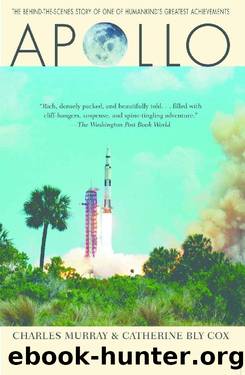Apollo by Catherine Bly Cox & Charles Murray

Author:Catherine Bly Cox & Charles Murray [Cox, Catherine Bly]
Language: eng
Format: epub
Publisher: South Mountain Books
Published: 2004-07-28T23:00:00+00:00
1
âFlight Operations was not born effective,â one veteran reminisced. âIt became effective.â Back in 1959, when the Space Task Group was first struggling to put the program together, nothing was yet Standard Operating Procedure. âWe accept this Control Center and operations mode that we have now,â said Glynn Lunney, who was part of the Operations Division from the Space Task Groupâs first day, âbut the truth is, it easily could have [evolved in] any number of other ways, and it could easily have been a failure.â
In the beginning, preparing for Mercury, it wasnât clear how much Operations would have to do. In the flight-testing of aircraft, which was the closest analogue, the groundâs role consisted of getting the airplane into the best possible mechanical condition, spelling out the dayâs test objectives for the pilot, and retrieving the data from the instrumentation after the plane landed. During the flight itself, the people on the ground talked to the pilot and kept track of where he was, but little beyond that.
Thus when the Operations Division at the Space Task Group began thinking in early 1959 about what their job really was, the possibilities were vague and open-ended. Because none of Mercuryâs systems was actually operated from the ground, many from the N.A.C.A. envisioned a flight-test operation that would check out the capsule before launch and then let the astronaut do the rest. It didnât make sense to acquire a lot of real-time data on the ground if nobody was going to do anything with it.
And yet it didnât seem adequate to stand on the ground with just a voice link to see how things were going. The operations people at Langley began groping toward another, more ambitious understanding of their role. âI donât know how to describe it exactly,â Lunney recalled, âbut we began to realize that, âHey, weâre going to fly this thing around the world!â and then a number of things began to emerge.â There was already the matter of range safety, for example. If you were launching an unmanned rocket from the Cape, you had range-safety limits. If the telemetry told you that the rocket was outside the safety limits, you blew it up before it descended on downtown Cocoa Beach. The Space Task Group people began to conceive of similar kinds of limits that protected not âthe rangeâ or the population of the Cape, but rather the man inside the spacecraft.
Thinking about them quickly led the Operations Division to realize that, whatever these limits were, they would keep changing during the mission. For the first few minutes after launch, the capsule would have its escape rocket; then the escape rocket would be jettisoned and a new set of procedures would come into play. A new concept that focused on the alternative ways of getting the astronaut back at different points in the mission began to emerge. This was the concept of the abort mode.
âWe began to realize there were some things we could make decisions about,â Lunney continued.
Download
This site does not store any files on its server. We only index and link to content provided by other sites. Please contact the content providers to delete copyright contents if any and email us, we'll remove relevant links or contents immediately.
| Africa | Americas |
| Arctic & Antarctica | Asia |
| Australia & Oceania | Europe |
| Middle East | Russia |
| United States | World |
| Ancient Civilizations | Military |
| Historical Study & Educational Resources |
The Bomber Mafia by Malcolm Gladwell(1183)
Submerged Prehistory by Benjamin Jonathan; & Clive Bonsall & Catriona Pickard & Anders Fischer(1162)
Facing the Mountain by Daniel James Brown(1135)
The Dawn of Everything by David Graeber & David Wengrow(1111)
The Way of Fire and Ice: The Living Tradition of Norse Paganism by Ryan Smith(1033)
Wandering in Strange Lands by Morgan Jerkins(1018)
Driving While Brown: Sheriff Joe Arpaio Versus the Latino Resistance by Terry Greene Sterling & Jude Joffe-Block(1003)
Tip Top by Bill James(1002)
Evil Geniuses: The Unmaking of America: A Recent History by Kurt Andersen(1001)
Red Roulette : An Insider's Story of Wealth, Power, Corruption, and Vengeance in Today's China (9781982156176) by Shum Desmond(1000)
F*cking History by The Captain(969)
It Was All a Lie by Stuart Stevens;(941)
White House Inc. by Dan Alexander(905)
Evil Geniuses by Kurt Andersen(903)
Treasure Islands: Tax Havens and the Men who Stole the World by Nicholas Shaxson(880)
American Dreams by Unknown(859)
American Kompromat by Craig Unger(849)
The Fifteen Biggest Lies about the Economy: And Everything Else the Right Doesn't Want You to Know about Taxes, Jobs, and Corporate America by Joshua Holland(816)
The First Conspiracy by Brad Meltzer & Josh Mensch(812)
